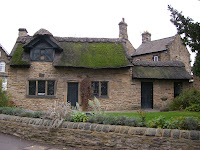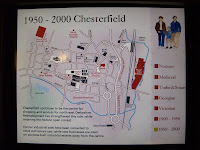


After a substantial, full English breakfast with homemade sausage in the dining/living room of the farmhouse (and delightful chat with fellow travelers from outside Liverpool and the quiet, sweet-natured farmer John), we were picked up by Anne-Marie in the CouncilMobile –an official Chesterfield borough van with a volunteer driver, again one of Anne-Marie’s staff – Bryan. Our luck with English weather had finally run its course, and we were treated to the weather that the moors are known for – rainy, cold, and bleak. As we drove across the moors of the Pennines and Peak district, we could almost spot Heathcliff and Cathy among the bracken and faded heather.

 It is a beautiful, bucolic spot (although I doubt the sheep think so). We ducked into the local church to see another local custom - the hanging of paper birdcage-type thingys called garlands when a young, unmarried woman dies. It is supposed to be in lieu of the decorations that would have adorned the church for her marriage, and they are made by her girlfriends and female relatives. There are four that remain hanging in the church.
It is a beautiful, bucolic spot (although I doubt the sheep think so). We ducked into the local church to see another local custom - the hanging of paper birdcage-type thingys called garlands when a young, unmarried woman dies. It is supposed to be in lieu of the decorations that would have adorned the church for her marriage, and they are made by her girlfriends and female relatives. There are four that remain hanging in the church.

 The museum was a gem - very well done. It told the plague story - both the nature, history and movement of the plague and its effect on Eyam - and then how Eyam recovered through lead mining and other industries.
The museum was a gem - very well done. It told the plague story - both the nature, history and movement of the plague and its effect on Eyam - and then how Eyam recovered through lead mining and other industries. After leaving Eyam, we stopped for lunch at the site of the oldest working water-powered mill in Derbyshire?...England?...I missed that part. Even in the rain and cold, there were many other travelers walking the paths around the historic site and fighting for a seat in the warm restaurant. Revived, we left for the main attraction, Chatsworth, ancestral home of the Duke and Duchess of Devonshire and frequent movie set (most recently for Duchess with Keira Knightly).
After leaving Eyam, we stopped for lunch at the site of the oldest working water-powered mill in Derbyshire?...England?...I missed that part. Even in the rain and cold, there were many other travelers walking the paths around the historic site and fighting for a seat in the warm restaurant. Revived, we left for the main attraction, Chatsworth, ancestral home of the Duke and Duchess of Devonshire and frequent movie set (most recently for Duchess with Keira Knightly). 


Although it was pouring rain, windy and cold, we took a quick walk in the gardens to the famous Cascade for a photo shoot. We had done serious damage in the gift shop, and the bags were banging against our legs in the wind. Bryan graciously got the van for us and we headed for a warming pot of tea at the estate's Farm Village tea room. Floor to ceiling windows looked out over the rolling landscape, a carefully manicured man-made park made to look "natural". If only it was sunny! But it was beautiful nonetheless.
We had made it through Chatsworth in somewhat record time, so we decided to shift the visit to Anne-Marie's museum to the day's schedule (Friday morning was going to be tight). Turned out to be a great decision, because it was great fun to be roaming the museum at night with the place all to ourselves. Anne-Marie has done a stellar job with this museum - fitting wonderful exhibits into a challenging space.

In future blogs I intend to go into more depth about the museums we visited and things we learned, and this museum will certainly be featured. One thing of note I will mention here - the Chesterfield Museum was given a special award this year by the borough Council for inspiration and 
Evidently just about every evening the local youth go from pub to pub to pub into the wee hours of the morning, pretty much taking up the streets in a noisy fashion that recalls our more excessive Halloween street parties. The Halloween analogy also extends to what they wear - although we were shocked (and felt terribly old) to discover that the ultra short hot pants and generally suggestive, flashy attire of the girls in fact were not costumes but what was considered fash



No comments:
Post a Comment